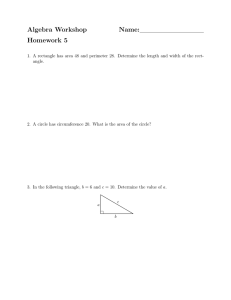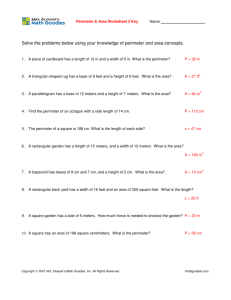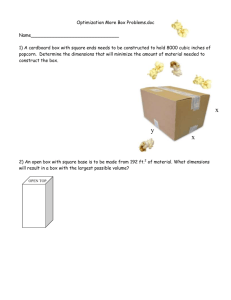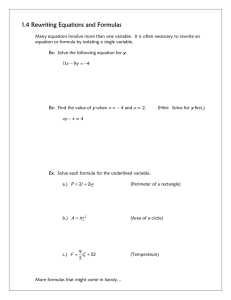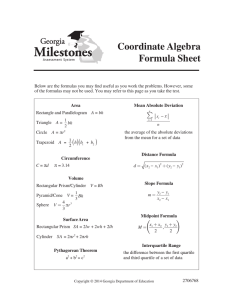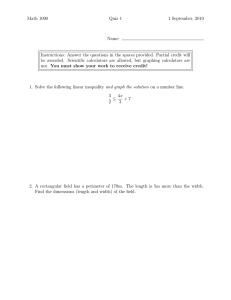CLF912
advertisement
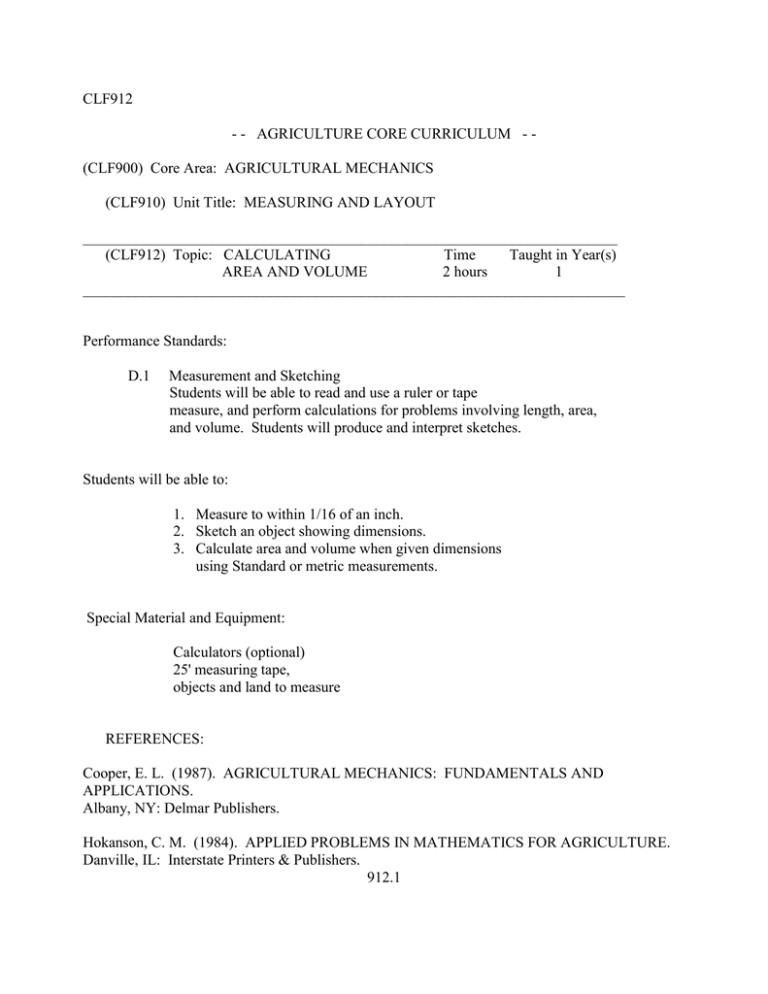
CLF912 - - AGRICULTURE CORE CURRICULUM - (CLF900) Core Area: AGRICULTURAL MECHANICS (CLF910) Unit Title: MEASURING AND LAYOUT _______________________________________________________________________ (CLF912) Topic: CALCULATING Time Taught in Year(s) AREA AND VOLUME 2 hours 1 ________________________________________________________________________ Performance Standards: D.1 Measurement and Sketching Students will be able to read and use a ruler or tape measure, and perform calculations for problems involving length, area, and volume. Students will produce and interpret sketches. Students will be able to: 1. Measure to within 1/16 of an inch. 2. Sketch an object showing dimensions. 3. Calculate area and volume when given dimensions using Standard or metric measurements. Special Material and Equipment: Calculators (optional) 25' measuring tape, objects and land to measure REFERENCES: Cooper, E. L. (1987). AGRICULTURAL MECHANICS: FUNDAMENTALS AND APPLICATIONS. Albany, NY: Delmar Publishers. Hokanson, C. M. (1984). APPLIED PROBLEMS IN MATHEMATICS FOR AGRICULTURE. Danville, IL: Interstate Printers & Publishers. 912.1 EVALUATION: Quiz by instructor. TOPIC PRESENTATION: CALCULATING AREA AND VOLUME A. Calculating Area 1. Square measure is a system for measuring area. The area of an a object is the amount of surface contained within defined limits. For example, the square below covers four square inches of this sheet of paper. a. The perimeter of the square is the total length of its sides. perimeter = P = 2 x length + 2 x width = (2 x 2) + (2 x 2) = 8 in b. The area of a square or rectangle is equal to the length times the width. area = length x width 2 x 2 = 4 2. Finding the area of circles. a. The perimeter of a circle is equal to the diameter (d) of the circle times pi (π). Pi is the ratio of a circles perimeter to its diameter. This ratio is 22/7 or approximately 3.14. Pi is constant for all circles. The perimeter of a circle is known as its circumference. Perimeter of a circle = π x d = 3.14 x d b. The area of a circle is equal to pi times the radius squared. The radius of a circle is half the diameter: Area of a circle = π x r2 c. For example, a circular grain silo has round floor 18 feet in diameter. The perimeter (circumference) of the floor is Perimeter = 3.14 x 18 = 56.52 feet The area of the floor is Area = 3.14 x (9 x 9) = 3.14 x 81 = 254.34 ft2 3. Finding the area of the curved surface of a cylinder. a. The curved-surface area of a cylinder is equal to the circumference (π x d) of an end times the height (h). 912.2 Area of a cylinder = A = (π x d) x h b. Example - If the silo in the example above is 50 feet tall: The area of the sides of the silo is: Area = (3.14 x 18) x 50 = 2826 ft2 4. Finding the area of a triangle. a. The area of a triangle is equal to one half the base(b) times the height (h). Area = 1/2 x (base x height) b. Example - what is the area of the triangular wall of a storage shed with a base of 2 meters and a height of 3 meters The area of the wall is: Area = 1/2 x ( 2 x 3) = 3 m2 5. Finding the area of a trapezoid a. The area of a trapezoid is equal to the height (h) times the average of the two parallel sides or bases (b1 and b2). Area of a trapezoid = h x (b1 + b2)/2 b. Example: Calculate the area of the trapezoid-shaped field with the following measurements: b1 b2 h = = = 150 meters 200 meters 120 meters Area of trapezoid = 120 x (150 + 200)/2 = 120 x (350/2) = 120 x 175 = 21,000 m2 = 21 hectares ________________________________________________________________________________ ACTIVITY: 1. Take actual measurement of plots and fields around the school shop or farm and determine individual and total acreage. 912.3 2. Determine how much sheet metal was used in constructing a barrel, feed bin, etc. Calculate the amount of paint required to paint the inside and outside of the silo in the example above. _________________________________________________________ B. Calculating Volume 1. A cubic measure is a system of measurement of volume or capacity of an object expressed in cubic units. A cubic measure requires three dimensions: a. Linear measure adds only one dimension to find total distance. b. Square measure multiplies two dimensions to find area of a surface. c. Cubic measure multiplies three dimensions (length, width, and height) to find the volume of various types of structures and containers. d. When determining the volume of an object, all measurements must be expressed in the same units of measurement. 2. Finding the volume of rectangular solids and cubes. a. The volume of a rectangular solid is equal to the length (l) times the width (w) times the height (h). Volume of a rectangular solid = l x w x h b. Example - Determine the volume of the rectangular crate pictured below Volume = 6 x 4 x 4 = 96 ft3 3. c. A cube is a special rectangular solid where length = width =height. d. The volume of a triangular prism is equal to the area of the triangle times the length of the prism. e. The volume of a trapezoidal prism is equal to the area of the trapezoid times the length of the prism. This is true as long as the ends of the prisms meet the sides at a 90 degree angle. Finding the volume of cylinders and cones. 912.4 a. The volume of a cylinder is equal the area of the circular base (π x r 2) times the height (h) of the cylinder. Volume of a cylinder = (π x r 2) x h b. The volume of a cone is equal to 1/3 times the area of the circular base (π x r 2) times the height (h) of the cone. Volume of a cone = 1/3 x (π x r 2) x h ________________________________________________________________________________ ACTIVITY: 1. Measure various rectangular and cylindrical containers or buildings and determine their volumes. 2. Measure a paper-cone cup and calculate how much water it can hold. _________________________________________________________ 912.5
